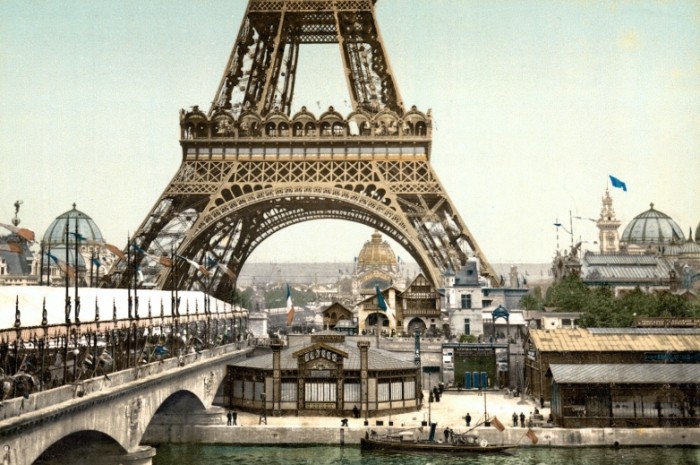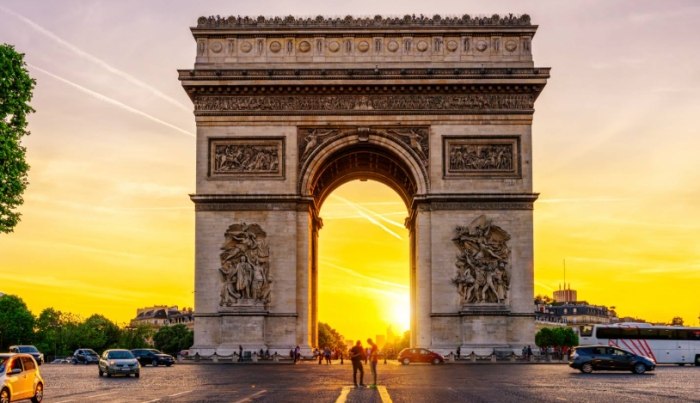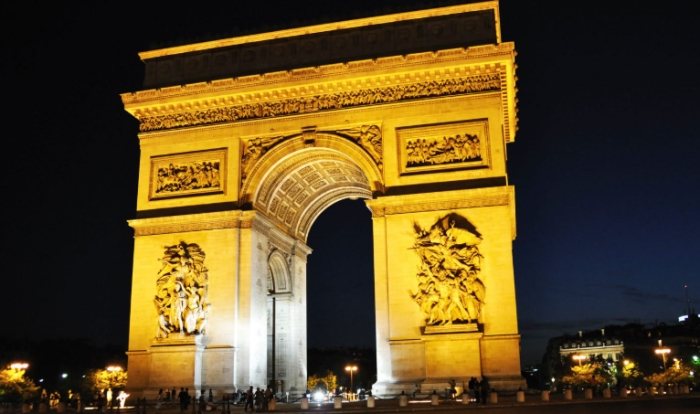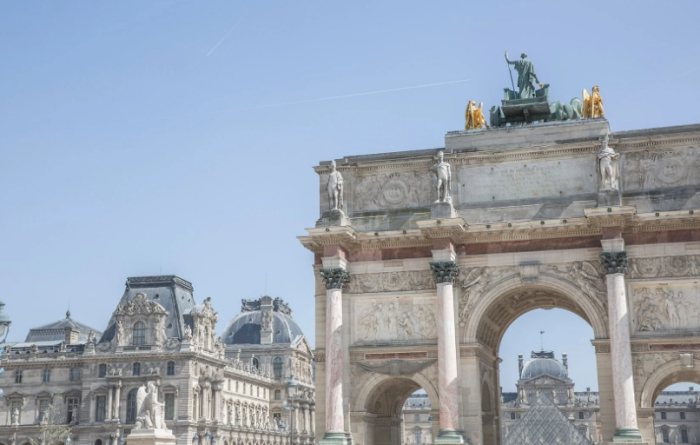History of Paris: From Ancient Roots to Modern Capital
Advertisements
What is the history of Paris? Explore the fascinating timeline of France's capital – from its Roman roots as Lutetia to medieval marvels like Notre-Dame, revolutionary upheavals, and its rise as the iconic 'City of Light' we know today.
Table of Contents
-
- Prehistoric and Roman Foundations
- Medieval Paris: Growth and Conflict
- Renaissance and Early Modern Paris: Cultural and Political Transformation
- 19th and 20th Century Paris: Industrialization, Modernization, and Conflict
- Modern Paris: A Global Cultural and Economic Hub
- Time Axis of Key Events in the History of Paris
- Character Profiles in the History of Paris
- Classic Interpretations of the History of Paris
- Q&A
Prehistoric and Roman Foundations

1. Early Settlements: The Parisii Tribe
- Origins of the Name: The history of Paris begins in prehistoric times, with evidence of human settlement dating back to around 4200 BCE. However, the city as we know it today owes its name to the Parisii, a Celtic tribe that inhabited the Île - de - la - Cité, an island in the Seine River, around 250 BCE. This small island was an ideal location for a settlement due to its strategic position on the river, which served as a natural trade route.
- Daily Life of the Parisii: The Parisii were skilled farmers, fishermen, and traders. They lived in simple wooden huts and engaged in activities such as pottery - making and metalworking. Their society was organized around a chief, and they had their own religious beliefs and rituals, which were centered around the natural elements and the river.
2. Roman Conquest: Lutetia Parisiorum
- The Roman Arrival: In 52 BCE, Julius Caesar's Roman legions conquered the Parisii territory. The Romans renamed the settlement Lutetia Parisiorum, which means "mid - water dwelling of the Parisii." They began to transform the city, building roads, aqueducts, and public baths. The Forum of Lutetia, located near the present - day Saint - Germain - des - Prés area, became the political and commercial center of the city.
- Architectural Contributions: Roman architecture had a lasting impact on the history of Paris. The Arena of Lutetia, an amphitheater that could seat up to 15,000 people, was built for gladiatorial contests and other public spectacles. The Baths of Cluny, a well - preserved Roman bath complex, showcased the Romans' advanced engineering skills in water supply and heating systems.
Medieval Paris: Growth and Conflict

1. The Carolingian and Capetian Eras
- Carolingian Influence: During the Carolingian dynasty (8th - 9th centuries), Paris became an important religious and cultural center. The Abbey of Saint - Denis, located just north of the city, was founded in the 7th century and became the burial place of French kings. The Carolingians also contributed to the construction of churches and monasteries in Paris, which helped to spread Christianity throughout the region.
- Capetian Dynasty and City Expansion: In 987, Hugh Capet was elected king of France, and Paris became the capital of the kingdom. The Capetian kings began to expand the city beyond the Île - de - la - Cité. They built the Louvre Fortress on the right bank of the Seine as a defensive structure and a royal residence. The city walls were also extended to protect the growing population.
2. The Hundred Years' War and the Black Death
- Hundred Years' War Impact: The Hundred Years' War (1337 - 1453) between France and England had a profound impact on the history of Paris. The city was besieged several times, and the population suffered greatly from famine and disease. In 1420, the Treaty of Troyes recognized Henry V of England as the heir to the French throne, and Paris came under English control. However, Joan of Arc's military campaigns in the 1420s helped to rally the French forces, and Paris was eventually liberated in 1436.
- Black Death Devastation: The Black Death, a pandemic that swept through Europe in the 14th century, also hit Paris hard. It is estimated that up to half of the city's population perished from the disease. The plague had long - lasting social and economic consequences, leading to labor shortages and a decline in trade.
Renaissance and Early Modern Paris: Cultural and Political Transformation

1. The Renaissance in Paris
- Cultural Flourishing: During the Renaissance (15th - 16th centuries), Paris experienced a cultural renaissance. The city became a center of learning, with the establishment of universities such as the Collège de France. Artists, writers, and scholars flocked to Paris, and the city's architecture began to reflect the Renaissance style. The Hôtel de Ville (City Hall), built in the 16th century, is a prime example of Renaissance architecture in Paris.
- Printing Press Revolution: The invention of the printing press in the 15th century had a significant impact on the history of Paris. It led to the widespread dissemination of knowledge and ideas, and Paris became a major publishing center. Books on a variety of subjects, including religion, science, and literature, were printed and distributed throughout Europe.
2. The French Revolution
- Causes and Events: The French Revolution (1789 - 1799) was a watershed moment in the history of Paris. The revolution was sparked by a combination of social, economic, and political factors, including widespread poverty, food shortages, and the absolute monarchy of King Louis XVI. In July 1789, the people of Paris stormed the Bastille, a symbol of royal tyranny, marking the beginning of the revolution.
- Political Changes: The revolution led to the overthrow of the monarchy, the establishment of a republic, and a series of radical political changes. The Reign of Terror (1793 - 1794) saw the execution of thousands of people, including King Louis XVI and Queen Marie Antoinette. However, the revolution also paved the way for the modern French state and the principles of liberty, equality, and fraternity.
19th and 20th Century Paris: Industrialization, Modernization, and Conflict

1. The Industrial Revolution and Urbanization
- Industrial Growth: In the 19th century, Paris underwent rapid industrialization. New factories were built, and the city's population grew exponentially as people migrated from rural areas in search of work. The development of the railway system in the mid - 19th century further connected Paris to the rest of France and Europe, facilitating trade and travel.
- Urban Planning and Modernization: Baron Haussmann, the Prefect of the Seine from 1853 to 1870, was responsible for a major urban renewal project in Paris. He demolished many of the city's narrow, medieval streets and replaced them with wide boulevards, parks, and public squares. The construction of the Paris Métro in the late 19th and early 20th centuries also improved the city's transportation infrastructure.
2. World Wars and Occupation
- World War I: During World War I (1914 - 1918), Paris was relatively safe from direct combat, but the war had a significant impact on the city. Many Parisian men were drafted into the army, and the city became a center for war production and medical care for wounded soldiers. The war also led to social and cultural changes, as women took on new roles in the workforce.
- World War II and Occupation: World War II (1939 - 1945) brought a period of occupation and hardship to Paris. In 1940, German forces occupied the city, and the French government collaborated with the Nazis for a time. However, the French Resistance played an important role in sabotaging German operations and providing intelligence to the Allies. Paris was liberated by Allied forces in August 1944.
Modern Paris: A Global Cultural and Economic Hub

1. Post - War Reconstruction and Cultural Renaissance
- Rebuilding the City: After World War II, Paris underwent a period of reconstruction. The city was rebuilt using modern architectural styles, while also preserving many of its historic landmarks. The construction of the Centre Pompidou in the 1970s, with its innovative design and focus on contemporary art, marked a new era in Parisian culture.
- Cultural Events and Festivals: Paris has long been a center of cultural events and festivals. The Cannes Film Festival, although held in Cannes, is closely associated with the French film industry based in Paris. The Paris Fashion Week is one of the most prestigious fashion events in the world, showcasing the latest designs from top fashion houses.
2. Economic and Social Developments
- Economic Powerhouse: Today, Paris is a major economic powerhouse in Europe. It is home to the headquarters of many multinational corporations, particularly in the finance, fashion, and tourism sectors. The city's stock exchange, the Euronext Paris, is one of the largest in Europe.
- Social Diversity: Paris is a highly diverse city, with people from all over the world calling it home. This diversity is reflected in the city's cuisine, art, and culture. The Quartier Latin, for example, is known for its vibrant student life and multicultural atmosphere.
Time Axis of Key Events in the History of Paris
| Time Period | Key Events |
|---|---|
| 250 BCE - 52 BCE | Settlement of the Parisii tribe on the Île - de - la - Cité |
| 52 BCE - 5th century AD | Roman conquest and establishment of Lutetia Parisiorum; construction of Roman buildings such as the Arena of Lutetia and the Baths of Cluny |
| 987 - 1453 | Carolingian and Capetian eras; expansion of Paris beyond the Île - de - la - Cité; construction of the Louvre Fortress; Hundred Years' War and liberation of Paris |
| 14th - 16th centuries | Impact of the Black Death; Renaissance in Paris with cultural flourishing, establishment of universities, and construction of Renaissance - style buildings |
| 1789 - 1799 | French Revolution; storming of the Bastille; overthrow of the monarchy; Reign of Terror |
| 19th century | Industrial Revolution in Paris; urban planning by Baron Haussmann; construction of the Paris Métro |
| 1914 - 1945 | World War I and its impact on Paris; World War II and German occupation; liberation of Paris in 1944 |
| Post - 1945 | Post - war reconstruction; cultural renaissance with the construction of the Centre Pompidou; Paris Fashion Week and other cultural events; economic and social developments |
Character Profiles in the History of Paris
1. Joan of Arc
- Life and Contributions: Joan of Arc, a peasant girl from Lorraine, played a crucial role in the history of Paris during the Hundred Years' War. In 1429, she led the French army to several important victories, including the lifting of the siege of Orléans. Her military successes helped to rally the French forces and paved the way for the liberation of Paris in 1436.
- Legacy: Joan of Arc was canonized as a saint in 1920. She is remembered as a symbol of French nationalism and courage. Her statue stands in the Place des Pyramides in Paris, commemorating her contributions to the country.
2. Baron Haussmann
- Urban Planning Vision: Baron Georges - Eugène Haussmann was the Prefect of the Seine from 1853 to 1870. He is best known for his ambitious urban renewal project in Paris. Haussmann's plan involved demolishing many of the city's medieval streets and replacing them with wide boulevards, parks, and public squares.
- Impact on Paris: Haussmann's transformation of Paris had a lasting impact on the city's appearance and functionality. The wide boulevards made it easier for the army to move through the city in case of a revolution, and the new parks and squares provided spaces for public recreation. However, his project also displaced many poor residents of the city.
Classic Interpretations of the History of Paris
1. Literary Interpretations
- Victor Hugo's "Les Misérables": Victor Hugo's epic novel "Les Misérables" provides a rich and detailed portrayal of 19th - century Paris. The novel explores the social and political issues of the time, including poverty, inequality, and the struggle for justice. The story is set against the backdrop of the June Rebellion of 1832, a significant event in the history of Paris.
- Émile Zola's "The Belly of Paris": Émile Zola's novel "The Belly of Paris" focuses on the Les Halles market, the central food market of Paris in the 19th century. The novel provides insights into the lives of the people who worked in the market, as well as the social and economic dynamics of the city.
2. Artistic Interpretations
- Claude Monet's Impressionist Paintings: Claude Monet, a key figure in the Impressionist movement, painted many scenes of Paris. His paintings of the Gare Saint - Lazare, a major railway station in Paris, capture the energy and modernity of the city during the late 19th century. Monet's use of light and color in his paintings reflects the changing atmosphere of Paris at that time.
- Auguste Rodin's Sculptures: Auguste Rodin, a renowned French sculptor, created many works that are associated with Paris. His sculpture "The Thinker" is one of the most iconic works of art in the world and can be found in the Musée Rodin in Paris. Rodin's sculptures often explore themes of human emotion and experience, and they reflect the cultural and artistic climate of Paris in the late 19th and early 20th centuries.
Q&A
1. What is the brief history of Paris?
The history of Paris dates back to prehistoric times, with the settlement of the Parisii tribe around 250 BCE. The Romans conquered the area in 52 BCE and named it Lutetia Parisiorum. Over the centuries, Paris grew and developed through various periods, including the medieval era with the Carolingian and Capetian dynasties, the Renaissance, the French Revolution, the Industrial Revolution, and the two World Wars. Today, Paris is a global cultural and economic hub, known for its rich history, iconic landmarks, and vibrant culture.
2. What are 5 facts about Paris?
- The Eiffel Tower: The Eiffel Tower, one of the most recognizable landmarks in the world, was built for the 1889 Exposition Universelle (World's Fair). It was initially intended to be a temporary structure but was later saved from demolition.
- The Louvre Museum: The Louvre Museum, located in the Louvre Palace, is the world's largest art museum. It houses over 38,000 objects, including famous works such as the Mona Lisa and the Venus de Milo.
- The Seine River: The Seine River runs through the heart of Paris and has played a crucial role in the city's history. It has served as a trade route, a source of water, and a source of inspiration for artists and writers.
- The Notre - Dame Cathedral: The Notre - Dame Cathedral, a masterpiece of Gothic architecture, was built between the 12th and 14th centuries. It is famous for its flying buttresses, rose windows, and gargoyles.
- The Paris Métro: The Paris Métro, the city's rapid transit system, opened in 1900. It has 16 lines and over 300 stations, making it one of the most extensive metro systems in the world.
3. Who built Paris originally?
The city of Paris as we know it today was not built by a single individual. The Parisii, a Celtic tribe, were the first to settle on the Île - de - la - Cité around 250 BCE. The Romans later conquered the area and began to develop the city, building roads, aqueducts, and public buildings. Over the centuries, various kings, emperors, and urban planners have contributed to the growth and development of Paris, including the Capetian kings, Baron Haussmann, and others.
4. Why is Paris called Paris?
The name "Paris" comes from the Celtic tribe that inhabited the area before the Roman conquest. The tribe was called the Parisii, and the city was named after them. The Romans renamed the settlement Lutetia Parisiorum, but over time, the name "Paris" became more commonly used. The exact origin of the name "Parisii" is uncertain, but it may have meant "the workers" or "the boatmen" in the Celtic language.
Advertisements